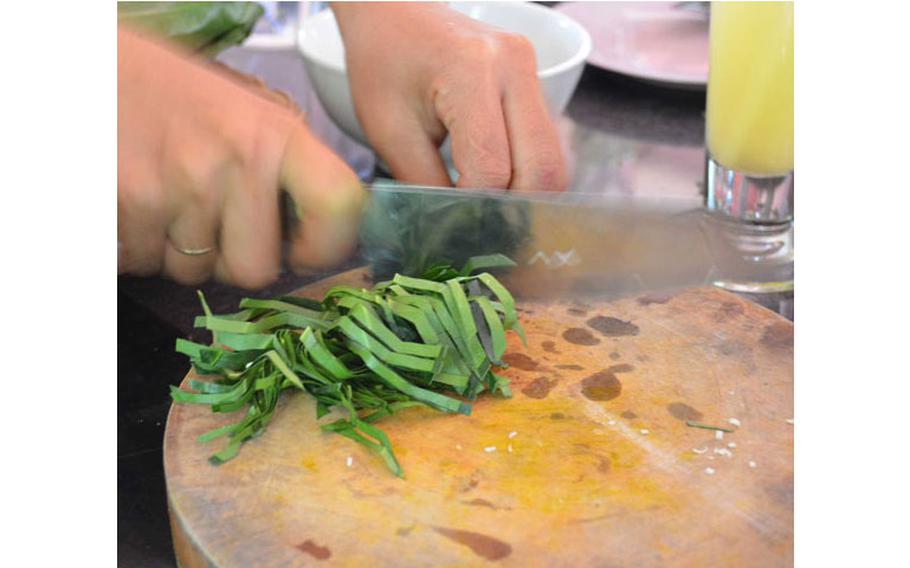Food & Drink
Discovering Kmer cuisine
Groove Korea (groovekorea.com) January 1, 2019

()
Tasting a cuisine at the source is an exhilarating experience that stimulates all senses. It doesn’t get any better than eating food made by experts on home soil. Local ingredients picked at their prime, dishes cooked in season by someone who learned them from his or her grandma and has been cooking them for years — what more can you ask for? So, when I travel, I make it a point to not only eat (a lot), but also learn how local dishes are made. A recent trip opened my eyes and stomach to a whole new world of what I would call “bodastic (bodacious + fantastic) fusion cuisine,” or as others would call it, Cambodian food.
We wanted to fully experience Cambodian — or Khmer — food on our trip, so we asked our hotel clerk to help us find a cooking school. She recommended “Cooks in Tuk Tuks,” a class being taught at the River Garden Hotel in Siem Reap. The class included a trip to a local wet market, training in Khmer techniques and a hearty meal of traditional Khmer dishes.
The highlight of the class was our Chef Instructor Soun Saroun, who is a graduate of the Sala Bai Hotel and Restaurant School (operated by a French non-profit offering impoverished Cambodians free one-year training in cooking, serving, bartending and front office management). Saroun was kind, cheerful, friendly and knowledgeable.
The trip to the wet market was good but nothing new for me. As a child I used to go to the wet market in the Philippines every day, having been raised at the hip of my Visayan grandmother. It was interesting to see the similarities between the Khmer women and my grandmother. My grandmother did it because that was how she was raised in the Visayas, where there were no refrigerators — or electricity for that matter — much the same as it is in modern-day Cambodia for many. The other students in the class, which was very small with only four students, found the wet market tour a blast. Their cameras could not stop clicking.
With fish jumping off cutting boards, chickens being plucked, snails baking in the sun, and various exotic fruits, and herbs and vegetables on display, it was a lively scene. We shopped for the ingredients we needed for the dishes we were cooking and were enlightened by our chef.
On to the River Garden Hotel, to cook. I had to fight the mosquitoes (Normal for nearly anywhere in Cambodia, so bring insect repellent!) but after pounding my herbs and slicing away the banana flower hearts and other veggies I began to appreciate the fusion of flavors we were creating. A heavy mix of spices and coconut permeated everything. There were elements of Thai, Indian, and Malay cuisine, but the end result was completely “Khmer.”
We began our culinary expedition with a salad of banana flowers and fresh greens drizzled with a Khmer dressing also made during the class. The dish took a back seat when we began preparing “amok,” the national dish. It was heavenly; the mixture of spices, coconut, and fish was an incredibly satisfying intersection of creamy, citrus, and sweet, yet a touch of spicy flavors amplified the meatiness of the dish while keeping it light. Having tried the same dish at several of the better restaurants in Siem Reap, Saroun’s interpretation was the hands-down winner. It captured the essence and beauty of the whole region. To accompany this delightful dish, we made some surprisingly simple hibiscus tea. The striking pink hue of the tea felt exotic despite the fact (as we learned) that hibiscus provides only the color; the sweetness comes from syrup.
Last came a dessert made with sweet potato, tapioca balls and coconut milk. Similar in many ways to some desserts of the Philippines, this dish again reminded me of my childhood. It was satisfyingly sweet and creamy without the addition of sugar or syrup. Yummy.
In all, the shopping, the chef, the lesson, and the food captured the best of Cambodia, the Khmer People, and their cuisine in a single experience.
Amok (Serves 4 to 6)
Ingredients: - 1 kg chicken, boneless white fish or tofu - 100g cabbage or spinach - Khmer spice mix – “Kroeung” – to taste (recipe below) - 200g lemon grass stalks, trimmed, remove outer leaves and chop - 100g galangal (or ginger) - 2 teaspoons Turmeric (recommend fresh but powdered will be okay) - 100g /4 cloves of garlic - 100g shallots - 6 dried red chilis - 4 Kaffir (Lime) leaves – ribs removed - Amok mix (recipe below) - 3 tablespoon fish Sauce - 100g palm sugar - 225 ml thick coconut milk - 1 teaspoon salt - 1 cup chicken stock
Directions: • Roughly cut the Kroeung-Khmer Spice mix and pound it in a mortar (or in a blender or food processor) until pasty. (Tip: Add a touch of water so the ingredients bind and blend better. Also, this mix can keep for up to a week in the refrigerator and longer in a freezer.)
• Clean the fish or chicken, slice into cubes and set aside.
• Make the Amok mix.
• Add the Kroeung-Khmer spice mix to your protein and mix well.
• In a wok or pan (high heat), add the Amok mix and the protein. Cook for three to five minutes. Add the cabbage or spinach. Let it come to a boil and lower the temperature to a simmer for another three to five minutes.
• Enjoy.
Name: Cooks in Tuk Tuks, Adventure in Classic Khmer Cuisine Address: The River Garden Hotel, 113 Mondul 111 Treang Village Slorkrum, Siem Reap, Cambodia Phone: +855-063-963-400 email: info@therivergarden.info Web Address: www.therivergarden.info
Groove Korea website